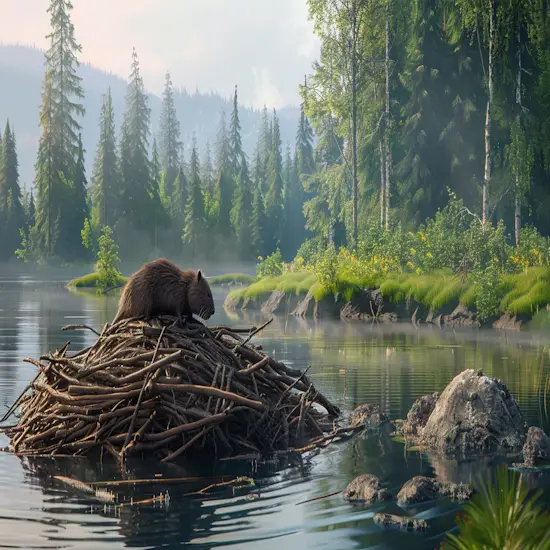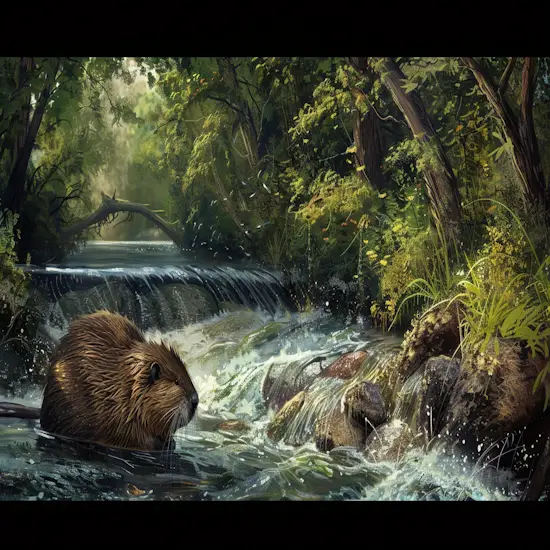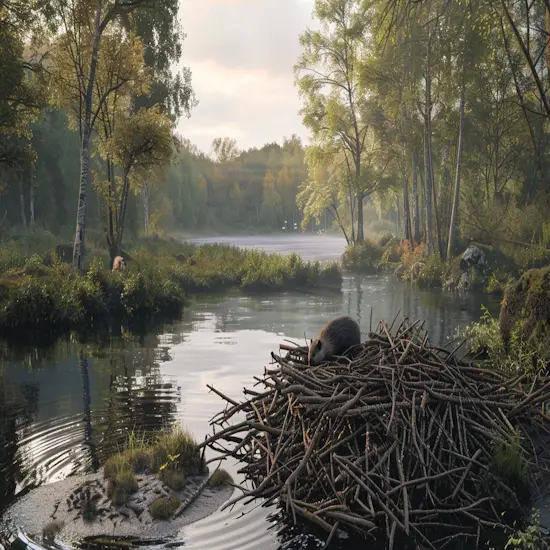Disclosure: We may earn commissions if you purchase products after clicking on a link from our site.
You might be curious about the timeline it takes for beavers to construct their intricate dams. From site selection to meticulous material gathering and the strategic placement of each component, the process is a fascinating display of their engineering prowess. But just how long does it truly take for these industrious creatures to complete such a task? The answer might surprise you as we uncover the intricacies of beaver dam construction and the patience required for this remarkable endeavor.

Table of Contents
Key Takeaways
- Beavers can build a dam in a few days to several weeks.
- Timing depends on factors like dam size, materials, and environment.
- Young beavers may take longer to construct a dam.
- Dam building is a continuous process for maintenance and expansion.
- Dam completion varies based on colony size and experience.

Site Selection
When choosing a site for their dam, beavers carefully identify a suitable location based on factors like water depth and proximity to food sources. They conduct an environmental assessment to confirm the area meets their needs for building a secure and functional structure.
Identification of Suitable Location
To find the perfect spot for a beaver dam, scout along the riverbank for a suitable location with a steady water supply and ample building materials. Look for areas where the water flow isn’t too fast, as this allows for easier dam construction. Beavers prefer to build in areas with a gentle slope, making it simpler to control the water level within the dam.
Additionally, make sure there are plenty of trees and shrubs nearby for building materials. These vegetation sources provide the necessary logs and branches for the dam’s structure. By selecting a location with these features, beavers can efficiently construct a sturdy dam that meets their needs for shelter and protection.
Environmental Assessment
To guarantee the suitability of the chosen location for building a beaver dam, conduct an environmental evaluation focusing on factors like water flow, available building materials, and proximity to vegetation sources.
When evaluating a site for a beaver dam, consider the following:
- Water Flow: Confirm the water flow in the area is sufficient for the beavers’ needs.
- Building Materials: Check for the availability of suitable materials like branches and mud for dam construction.
- Proximity to Vegetation: Choose a location near vegetation sources to provide food and building materials.
- Accessibility: Evaluate how easily beavers can access the site and transport materials for construction.

Material Gathering
You start by collecting the necessary building materials like branches, twigs, and mud. Once you have what you need, you transport them to the construction site.
Collection of Building Materials
Gathering the essential building materials for a dam is an important step in the construction process. Beavers meticulously select and collect materials to guarantee the stability and strength of their dam. Here are some key points to understand this critical phase:
- Beavers use their sharp teeth to fell trees and branches.
- They choose sturdy logs and sticks to form the primary structure.
- Mud and clay are gathered to fill in the gaps and reinforce the dam.
- Rocks and stones are strategically placed to add weight and stability.
Transportation and Storage
During the construction of a dam, beavers skillfully transport and store the materials they’ve gathered to ensure the structural integrity of their creation.
Beavers use their strong teeth and powerful jaws to cut down trees and shrubs. They then carry these materials using both their mouth and front paws to the dam site. Beavers are adept at maneuvering through water with logs and branches, sometimes even swimming with them.
Once at the desired location, they meticulously place the materials, interweaving and compacting them to form a sturdy barrier. To prevent the collected materials from floating away, beavers strategically add rocks and mud to anchor them in place. This careful transportation and storage process is vital for the successful construction of a beaver dam.

Construction Process
As the beavers construct their dam, they begin by establishing a solid foundation. Layer by layer, they meticulously build up the structure using sticks, mud, and stones. This process guarantees a sturdy and reliable dam that can withstand the force of flowing water.
Foundation Establishment
To establish the foundation of a beaver dam, the beavers meticulously select sturdy materials like branches and mud to create a solid base. This initial step is essential for the stability and longevity of the dam.
Here are key points to keep in mind in the foundation establishment process:
- Beavers survey the area to find suitable materials.
- They strategically place branches and twigs in a crisscross pattern.
- Mud is then added to fill gaps and create a water-resistant seal.
- The foundation must be compacted firmly to support the weight of the dam structure above.
Layered Building
After establishing a sturdy foundation for the dam, you proceed with the construction process by layering additional materials in a strategic pattern. Beavers meticulously place sticks, mud, rocks, and vegetation one on top of the other, ensuring each layer is compacted and secure.
This layering technique helps in strengthening the structure of the dam and making it more resistant to water flow. By alternating between different materials and ensuring each layer is tightly packed, beavers create a cohesive barrier that effectively retains water.
Layer by layer, the dam grows in height and width, with each added layer contributing to its overall strength and durability. This methodical approach to construction allows beavers to create dams that can withstand various water pressures and environmental conditions.

Maintenance and Expansion
Now, let’s talk about the ongoing efforts that beavers put into maintaining and expanding their dams. They continuously monitor the structural integrity, making adjustments as needed to guarantee stability.
Additionally, they’re always looking to expand their living space by modifying and adding to their existing dam structure.
Continuous Monitoring
For efficient maintenance and expansion, keep a close eye on the beavers’ dam-building activities. Regular monitoring is key to ensuring the dam remains functional and meets the beavers’ needs. Here are some tips to help you with continuous monitoring:
- Check Dam Integrity: Inspect the dam regularly to look for any signs of damage or wear.
- Observe Building Behavior: Watch how the beavers are constructing the dam and if any adjustments are needed.
- Monitor Water Flow: Keep an eye on how the dam affects water levels and flow in the area.
- Assess Surrounding Environment: Consider any changes in the environment that may impact the dam’s effectiveness.
Expansion and Modification
To guarantee the longevity and functionality of the beavers’ dam, regularly assess the need for expansion and modifications to accommodate their evolving requirements. As the environment changes and the beaver colony grows, it’s crucial to adapt the dam accordingly. Keep an eye out for signs such as increased water flow, overcrowding, or structural weaknesses.
Be proactive in making adjustments to prevent potential issues and ensure the dam continues to serve its purpose effectively. By expanding the dam when needed and making necessary modifications, you can help the beavers maintain a secure and sustainable habitat.
The Bottom Line
Ever wondered how long it takes for beavers to build a dam? Beavers are very creative and industrious. The construction process of the dam is complicated. It involves, gathering material and building the dam strong enough to protect the colony from predators.
This process takes a good amount of time. So, next time you see a beaver dam, remember it took those little engineers a lot of hard work and dedication. Did you know that a beaver can move up to 200 pounds of materials in a day? That’s like lifting a small adult human! Just goes to show the incredible strength and determination of these amazing animals.
If you want to learn how do beavers build dams, then read this article. Similarly, you can also learn how beavers learn to build dams and how beavers know where to build dams.
